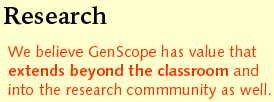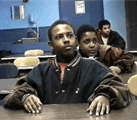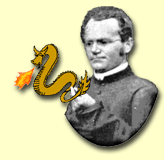
To further our understanding, we developed an assessment plan.
GenScope is no longer maintained or supported.
Visit Teaching Genetics with Dragons for our latest software.
![[GS Research]](../images/ban-research.gif)

|
As we developed GenScope, we not only created a new program that is useful to students and teachers, but we also studied its value to the
educational research community. GenScope gives students a way to investigate scientific and mathematical concepts through direct manipulation and
experimentation. This made it a new kind of learning tool and we wanted to understand if the nature of student learning with GenScope was also
new.
To further our understanding, we developed an assessment plan. |
|
Enter the NewWorm 
The NewWorm assessment used a fabricated species, NewWorms, to explore student understanding of introductory genetics, concepts and reasoning. Its design took into account five needs:
These needs were met by
| ||
|
What did we look for? We wanted to see if students understood various "dimensions" in genetics, so we identified specific modes of thinking to evaluate. The following links will bring you to selected illustrations (in .PDF format) from the NewWorm Assessment:

What did we find? We implemented the NewWorm assessment with students in 43 secondary life science classrooms from 1996 to 1999. Although early results showed modest gains in science reasoning ability for all groups, there was no difference between classes using print (non-GenScope) and those using computer-implemented (GenScope) material. In final trials, however, GenScope and non-GenScope classes differed in two major ways. First, student ability to reason about genetics improved using GenScope. By comparing user and non-user groups, we found the GenScope learning environment had brought about a fundamental, qualitative change in student thinking. This gain, absent in the typical biology classroom, provides evidence that technology-supported learning has value. Second, improvements were even greater when students used computers in the classroom, rather than in computer labs. The two classes that used GenScope in the classroom significantly outperformed all other groups in all years. We're excited by these initial findings and are continuing our research to determine their long term significance. What does this mean for the future? 
The GenScope project is officially over. Our efforts are now channeled into a successor program BioLogica, where our research will focus on embedding into the software those curricular activities that were most successful in GenScope. For more information about BioLogica, write info@concord.org. Coda The students who used GenScope, compared to the students who didn't, attempted more complex problems during standardized tests. The experience GenScope users gained while manipulating the computer to learn genetics seems to have given them the confidence to try unfamiliar material. They took risks in solving problems that non-GenScope users simply passed by. 
One more Tool Between the first and second years of assessment, we developed a set of curricular activities designed to support student performance, called Dragon Investigations. Why? Data analysis from the first year revealed that very few students gained the kind of higher-level reasoning targeted both by GenScope and by current educational reform standards. In response, we developed this set of curricular activities in Portable Document Format (PDF) that use the familiar GenScope dragons to scaffold development of the domain reasoning represented by the NewWorm. Print out and read Dragon Investigations and NewWorm Assessment. |
GenScope, A project of The Concord Consortium.
Copyright © 1999, All rights reserved.
Inquiries regarding GenScope can be sent to info@concord.org